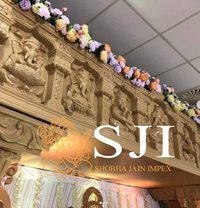South Indian Wedding Mandap
200000.00 - 1000000.00 NZD ($)
Product Details:
X
South Indian Wedding Mandap Price And Quantity
- 200000.00 - 1000000.00 NZD ($)
- 1 Set
South Indian Wedding Mandap Trade Information
- 100 Set Per Day
- 10 Days
Product Description
A South Indian wedding mandap, also known as a "kalyana mandapam" or "mantap," is a beautifully decorated structure that serves as the central stage for traditional South Indian wedding ceremonies. It is a significant element in South Indian weddings and holds cultural and religious importance.
Here are some key features and aspects of a South Indian wedding mandap:
1. Design and Structure: South Indian wedding mandaps are typically grand and ornate structures made of wood, metal, or a combination of both. They often have a square or rectangular base with pillars supporting a roof or canopy. The design may vary based on regional and personal preferences.
2. Decorations: Mandaps are elaborately decorated with flowers, fabrics, and other decorative elements. Mango leaves, marigold flowers, jasmine garlands, and banana tree stems are commonly used for decorations, symbolizing fertility and prosperity.
3. Color Scheme: The color scheme for mandap decorations is often vibrant and rich, with combinations of red, yellow, orange, green, and gold. These colors are considered auspicious in South Indian culture.
4. Pillars: The pillars of the mandap are typically adorned with intricate designs, and they may be wrapped with colorful fabrics or flowers. Some mandaps also have sculpted figurines or idols on the pillars.
5. Roof/Canopy: The roof or canopy of the mandap may be made of fabric, and it is often draped with silk or other luxurious materials. It is common to see intricate designs and motifs on the canopy.
6. Sacred Fire: In Hindu weddings, a sacred fire (agni) is an essential element of the ceremony. A fire pit is usually placed at the center of the mandap where the couple will perform various rituals, including the exchange of vows.
7. Idols and Deities: Images or idols of deities like Lord Ganesha and Lakshmi, who are considered auspicious, may be placed inside or near the mandap.
8. Vedic Priest: A Vedic priest conducts the wedding ceremony within the mandap, reciting sacred verses and guiding the couple through the rituals.
9. Seating: There are designated seating areas for the bride, groom, and their families within the mandap. Family members and close relatives sit around the mandap to witness the ceremony.
10. Traditional Rituals: Various traditional rituals and customs are performed in and around the mandap, including the exchange of garlands, tying the sacred thread (mangalsutra), and the seven vows (saptapadi).
11. Music and Chants: Traditional South Indian music and chants play a significant role in creating a spiritual and festive atmosphere during the wedding ceremony.
Overall, the South Indian wedding mandap is not just a physical structure but a sacred space where the couple takes their vows and begins their journey together as a married couple. It is a symbol of tradition, culture, and the sanctity of marriage in South India.
Enter Buying Requirement Details
Other Products in 'Wedding Mandap' category
Our major export markets are United State, Canada, United Kingdom, Asia, Australia, Central America, North America, South America, Eastern Europe, Western Europe and Middle East.







 English
English Spanish
Spanish French
French German
German Italian
Italian Chinese (Simplified)
Chinese (Simplified) Japanese
Japanese Korean
Korean Arabic
Arabic Portuguese
Portuguese













